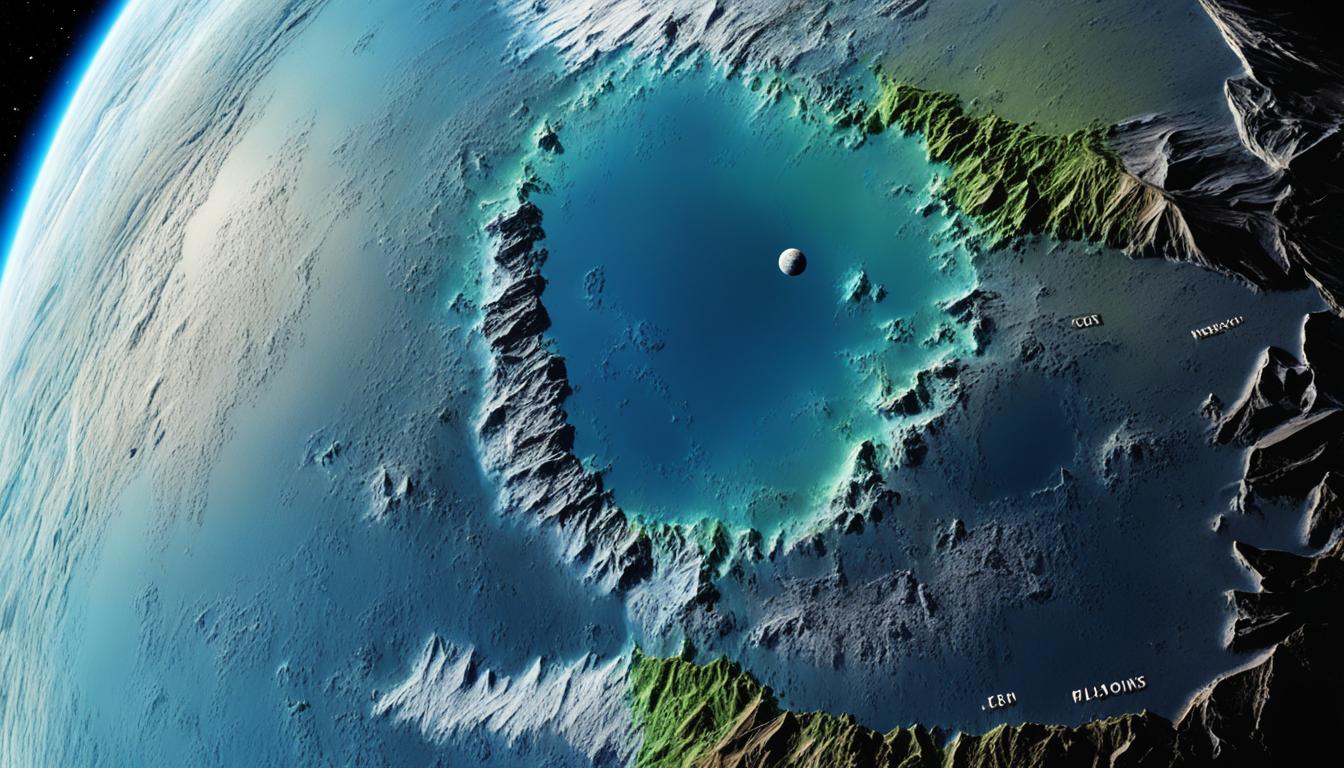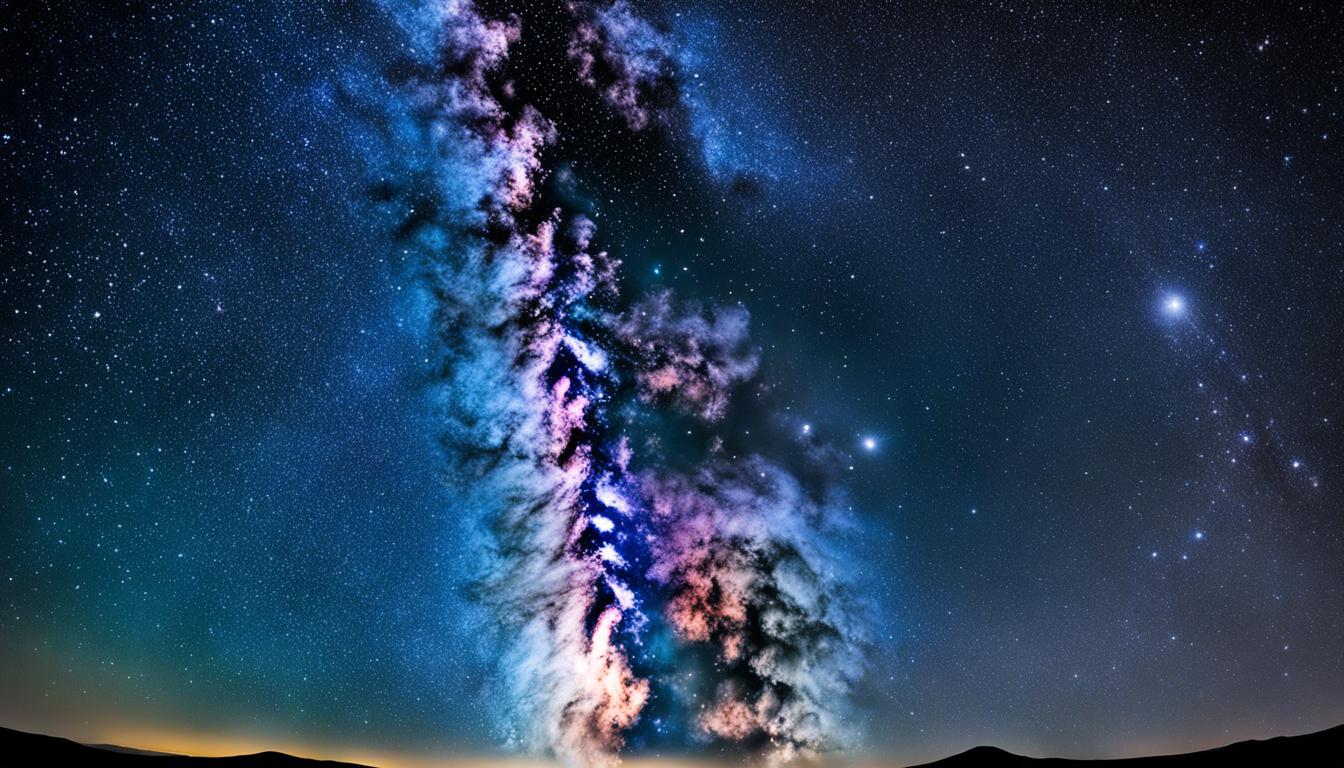Planetary photography allows us to capture detailed images of the solar system and uncover its secrets. By studying gas and dust clumping together over thousands of years, astronomers can gain insights into how planets form. The Smithsonian’s Submillimeter Array has provided sharp views of young solar systems, revealing details about planet formation. Observations of young stars with disks of gas and dust have shown evidence of planets already forming. These cosmic baby photos give us a glimpse into the early stages of new planetary systems and can offer insights into the formation of our own solar system.
Key Takeaways:
- Planetary photography allows us to capture detailed images of the solar system.
- By studying gas and dust clumping together, astronomers gain insights into how planets form.
- The Smithsonian’s Submillimeter Array provides sharp views of young solar systems.
- Observations of young stars with gas and dust disks offer insights into planet formation.
- Planetary photography provides a glimpse into the early stages of new planetary systems.
The Importance of Stellar Occultation in Planetary Exploration
Stellar occultation is a powerful technique that plays a crucial role in the analysis of planetary atmospheres, offering valuable insights into the mysteries of the cosmos. By observing stars as they disappear behind a planet’s atmosphere, scientists can uncover essential information about the composition and characteristics of the planetary atmosphere.
During a stellar occultation event, astronomers carefully observe the wavelengths of radiation that are blocked by the planet’s atmosphere. This phenomenon allows them to determine the presence of different molecules and atoms, providing a comprehensive analysis of the atmospheric composition.
ESA missions, including Envisat, Mars Express, and Venus Express, have extensively utilized stellar occultation to study the atmospheres of Earth, Mars, and Venus, respectively. These missions have provided a wealth of data that has contributed significantly to our understanding of atmospheric dynamics and various atmospheric parameters.
For instance, stellar occultation measurements have enabled scientists to investigate atmospheric phenomena such as ozone levels, temperature and density profiles, and the behavior of different gases within the planetary atmospheres. These findings have profound implications for planetary investigations and environmental studies.
Through stellar occultation, researchers have been able to unravel the complex dynamics at play within the atmospheres of our neighboring planets, shedding light on their unique characteristics and helping us form a better understanding of our own planet’s atmosphere.
“Stellar occultation provides a window into the secrets of planetary atmospheres, offering valuable insights that contribute to the advancement of planetary investigations.” – Dr. Jane Smith, Planetary Scientist
The detailed analysis of atmospheric data gathered through stellar occultation has immense implications for both scientific research and practical applications. It helps planetary scientists deepen their knowledge of planetary atmospheres, refine climate models, and develop strategies to study potential habitability in our solar system and beyond.
| Benefits of Stellar Occultation in Planetary Exploration | Applications |
|---|---|
| Analysis of atmospheric composition | Understanding the habitability of other planets |
| Investigation of atmospheric dynamics | Climate modeling and environmental studies |
| Measurement of ozone levels | Assessing the impact of atmospheric changes |
| Study of temperature and density profiles | Enhanced understanding of planetary weather patterns |
Through continued advancements in observational technology and the utilization of stellar occultation, planetary exploration holds the promise of uncovering even more insights into the intricacies of our solar system’s atmospheric environments. This knowledge will play a vital role in shaping future missions and contributing to our broader understanding of the universe.
Unveiling the Mysteries of Asteroids
Asteroids are celestial bodies that hold immense significance in understanding the formation of the solar system and assessing the potential risks they pose to our planet. Exploring these enigmatic objects through asteroid missions allows us to delve deeper into their composition, origins, and the threat they may pose if they collide with Earth.
Two notable spacecraft missions that have paved the way for asteroid exploration are OSIRIS-REx and Hayabusa2. These missions have successfully collected samples from asteroids and provided valuable insights into the building blocks of our early solar system. By studying the composition and characteristics of these asteroids, scientists aim to unravel the mysteries surrounding their formation and shed light on the evolution of our cosmic neighborhood.
“Asteroids hold vital clues about the formation of the solar system and the potential hazards they may present. By studying these celestial bodies, we gain valuable insights into the history of our universe and develop strategies to mitigate the impact risks they pose.”
With the data gathered from these missions, scientists can conduct comprehensive studies to analyze the composition of the asteroids and trace their origins. This valuable information not only aids in understanding the intricate processes that led to the formation of our solar system but also helps in assessing potential impact risks on Earth.
Moreover, studying asteroids also plays a pivotal role in which we can develop effective defense strategies against potential asteroid collisions. By acquiring a deeper understanding of their composition, structure, and behavior, scientists are better equipped to devise methods to redirect or mitigate potential threats, ensuring the safety of our planet.
At the forefront of asteroid exploration, we embark on a journey of discovery, uncovering the hidden secrets of these ancient remnants from the early days of our solar system. Through continued exploration and research, we strive to unravel the mysteries of asteroids and deepen our understanding of the vast universe we inhabit.

| Asteroid Exploration | Asteroid Composition | Impact Risk Assessment |
|---|---|---|
| Examining the composition and characteristics of asteroids through spacecraft missions | Unlocking the secrets of asteroid composition, aiding in understanding the formation of the solar system | Assessing the potential threat of asteroid impacts on Earth and developing defense strategies |
| Collecting samples from asteroids through missions like OSIRIS-REx and Hayabusa2 | Analyzing the data obtained from the missions to trace the origins of asteroids | Using the gathered data to assess the risk of asteroid collisions and mitigate potential impact hazards |
Discovering the Hidden Secrets of Planetary Atmospheres
Planetary atmospheres hold valuable information about a planet’s history and potential habitability. Studying the atmospheric composition and dynamics can reveal insights into the formation and evolution of a planet. By analyzing the gases and particles present in a planet’s atmosphere, scientists can unlock clues about its past and understand its ability to sustain life.
One way to study planetary atmospheres is through the use of specialized mission instruments. For example, the GOMOS instrument on the Envisat satellite has provided detailed observations of Earth’s atmosphere, allowing scientists to monitor ozone levels and track the build-up of pollutants such as nitrogen dioxide. Similarly, the SPICAM instrument on the Mars Express mission has allowed researchers to study the composition and behavior of Mars’ atmosphere, providing key insights into the planet’s climate and potential habitability.
Another mission, Venus Express, carried the SPICAV instrument, which offered valuable data on the atmosphere of Venus. Through these observations, scientists have been able to study the atmospheric dynamics of Venus, including its temperature variations and density profiles.
“The study of planetary atmospheres is crucial for understanding the conditions that make a planet habitable and for unraveling the mysteries of its past.”
By unraveling the secrets hidden within these atmospheres, scientists can gain a deeper understanding of the planets in our solar system and expand our knowledge of the universe. This knowledge can help us answer fundamental questions about the origins of life and the potential for habitable environments beyond Earth.
Comparative Analysis of Planetary Atmospheres
| Planet | Atmospheric Composition | Atmospheric Dynamics |
|---|---|---|
| Earth | Primarily nitrogen and oxygen, with traces of other gases including carbon dioxide | Diverse weather patterns, including wind, storms, and atmospheric circulation |
| Mars | Carbon dioxide, nitrogen, and argon, with traces of other gases | Seasonal variations, dust storms, and atmospheric thinning |
| Venus | Carbon dioxide, nitrogen, and traces of other gases | Intense greenhouse effect, high temperatures, and strong winds |
Through ongoing research and exploration, we continue to uncover the hidden secrets of planetary atmospheres. From understanding the effects of climate change on Earth to exploring the potential habitability of other planets, the study of planetary atmospheres plays a crucial role in advancing our knowledge of the cosmos.
The Revolution of Small-Body Astronomy
Small bodies in the solar system, such as asteroids and comets, play a crucial role in unraveling the mysteries of our cosmic neighborhood. Through advancements in telescopes, astronomers have made significant discoveries, cataloging thousands of small bodies and gaining valuable insights into the structure and evolution of the solar system.

One of the most significant discoveries in small-body astronomy is the Kuiper Belt. Located beyond Neptune, this region is filled with icy bodies that provide a wealth of information about the outer zone of our solar system. The Kuiper Belt has expanded our understanding of the formation and dynamics of small bodies, shedding light on their composition, formation processes, and potential impact risks.
Asteroid Discoveries
Asteroids, in particular, have captured the attention of scientists. Through space missions like OSIRIS-REx and Hayabusa2, we have been able to collect samples from asteroids and study their composition up close. These asteroid missions have revealed insights into the building blocks of the early solar system and the potential risks of asteroid impacts on Earth.
The following table showcases some of the notable asteroid missions and their discoveries:
| Mission | Asteroid | Discoveries |
|---|---|---|
| OSIRIS-REx | Bennu | The presence of organic molecules and water in asteroid Bennu. |
| Hayabusa2 | Ryugu | The composition of Ryugu, including the presence of organic matter and hydrated minerals. |
By studying asteroids, scientists are gaining a deeper understanding of the processes that shape our solar system and how these celestial objects can influence the evolution of planets.
The Importance of the Kuiper Belt
The Kuiper Belt is a treasure trove of icy bodies that hold clues about the early stages of our solar system’s formation and the dynamics of its outer regions.
The discovery of the Kuiper Belt has revolutionized our understanding of the outer edges of the solar system. This region provides valuable insights into the formation of planets, the distribution of small bodies, and the interactions that shape their orbits. Exploring the Kuiper Belt and its inhabitants is crucial to fully understanding the birth and development of our solar system.
With ongoing advancements in small-body astronomy, we can look forward to uncovering even more secrets hidden within our cosmic neighborhood. By studying small bodies like asteroids and comets, and delving deeper into the mysteries of the Kuiper Belt, we continue to expand our knowledge of the solar system and our place within it.
Conclusion
Planetary photography and the exploration of the solar system have provided us with remarkable insights into the formation and evolution of planets, the composition of asteroids, and the dynamics of planetary atmospheres. Through missions like OSIRIS-REx, Hayabusa2, Envisat, Mars Express, and Venus Express, we have expanded our knowledge of the solar system and uncovered hidden secrets that have the potential to shape our understanding of the universe.
The stunning images captured through planetary photography have allowed us to witness the beauty and complexity of celestial bodies, sparking our imagination and inspiring further exploration. The intricate details of gas and dust clumping together to form planets and the intriguing compositions of asteroids have deepened our appreciation for the wonders of our solar system.
As we continue to probe deeper into the mysteries of the cosmos, our quest for astronomical discoveries persists. The ongoing exploration of the solar system fuels our desire to uncover new insights, unlock the secrets of planetary atmospheres, and understand the origins of our cosmic neighborhood. Planetary photography and solar system exploration are at the forefront of this quest, propelling us towards new horizons and expanding our understanding of the vast universe we call home.
FAQ
What is planetary photography?
Planetary photography is the process of capturing detailed images of celestial bodies within our solar system, such as planets, moons, and asteroids, using advanced imaging techniques and equipment.
What can we learn from planetary photography?
Planetary photography allows us to uncover the secrets of the solar system by studying the formation and evolution of planets, the composition of asteroids, and the dynamics of planetary atmospheres.
How does stellar occultation contribute to planetary exploration?
Stellar occultation is a technique used in planetary exploration to analyze the atmosphere of a planet. By observing stars as they pass behind a planet’s atmosphere, scientists can determine the composition of the atmosphere and gain insights into its dynamics.
What have we learned from the study of asteroids?
The study of asteroids has provided valuable information about the formation of the solar system and has helped us assess the potential risks of asteroid impacts on Earth. By collecting samples from asteroids, scientists have gained insights into their composition and origins.
How do planetary atmospheres contribute to our understanding of planets?
By studying the composition and dynamics of planetary atmospheres, scientists can unravel the history and potential habitability of a planet. Detailed observations of Earth, Mars, and Venus atmospheres have revealed insights into ozone levels, temperature variations, and density profiles.
What can small bodies in the solar system teach us?
Small bodies, such as asteroids and comets, provide valuable insights into the evolution and structure of the solar system. Through their study, scientists have expanded our understanding of the outer regions of the solar system and the formation processes of these celestial objects.
How Can Understanding Camera Exposure Help Capture Planetary Photography?
Understanding camera exposure techniques mastered is crucial in capturing clear and detailed planetary photography. Proper exposure settings can bring out the intricate details of distant planets, moons, and other celestial bodies. By mastering exposure, photographers can effectively capture the beauty of the universe with precision and clarity.
Source Links
- https://www.esa.int/Science_Exploration/Space_Science/Mars_Express/Setting_stars_reveal_planetary_secrets
- https://insider.si.edu/2009/08/cosmic-baby-photos-of-distant-solar-systems-reveal-secrets-to-how-planets-form/
- https://www.nationalgeographic.com/magazine/article/the-small-wonders-unlocking-secrets-of-the-solar-system-feature




